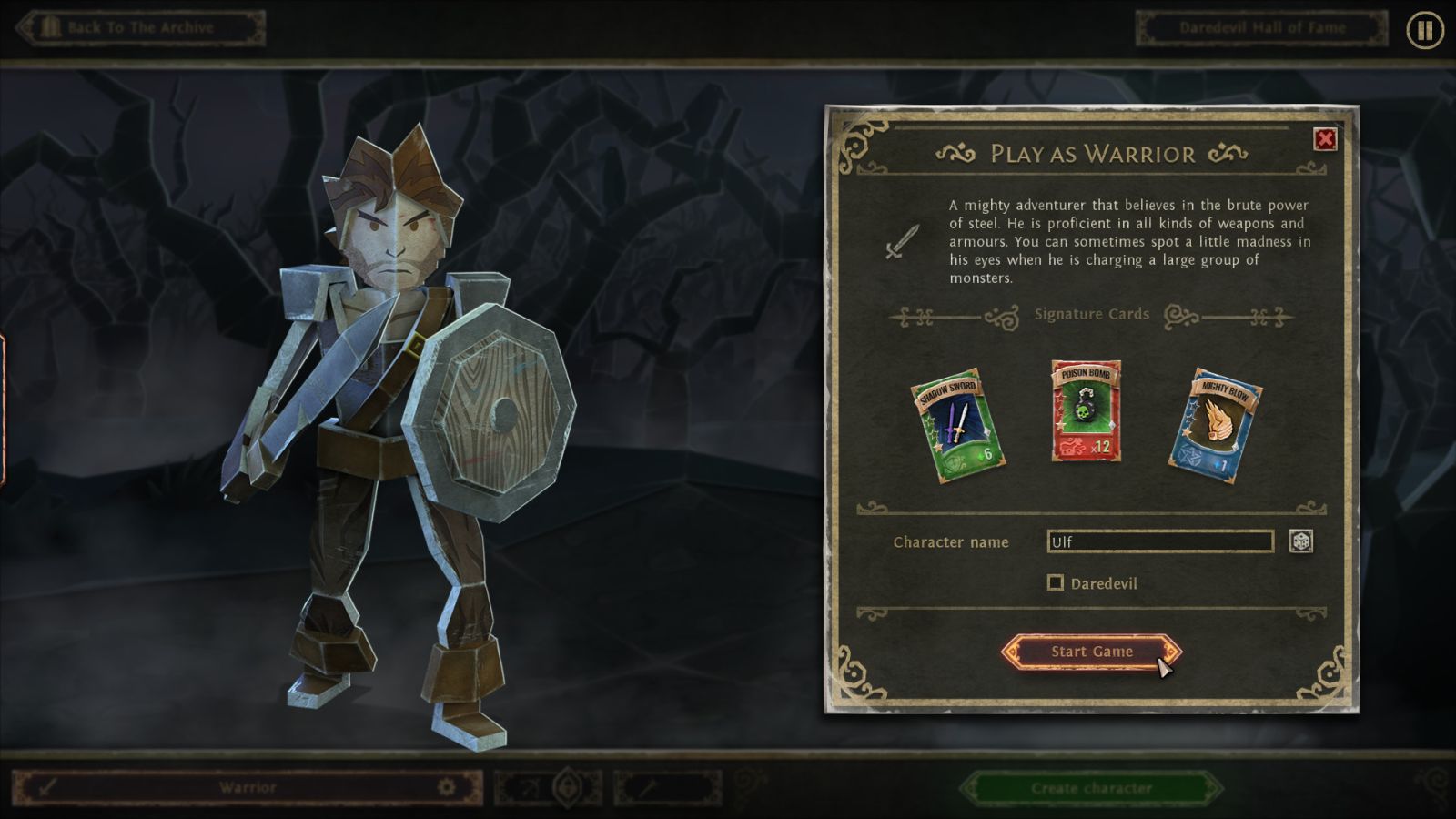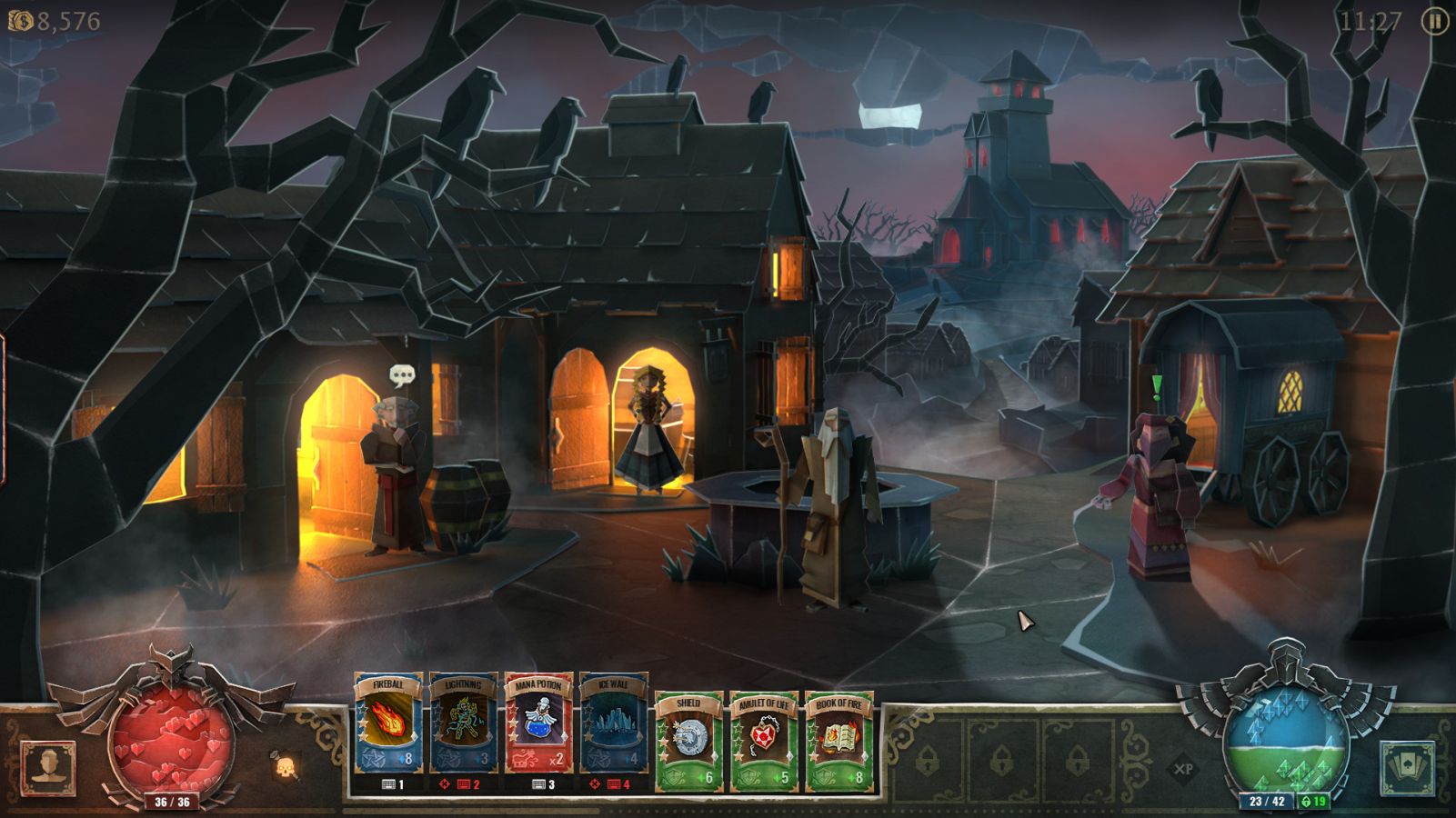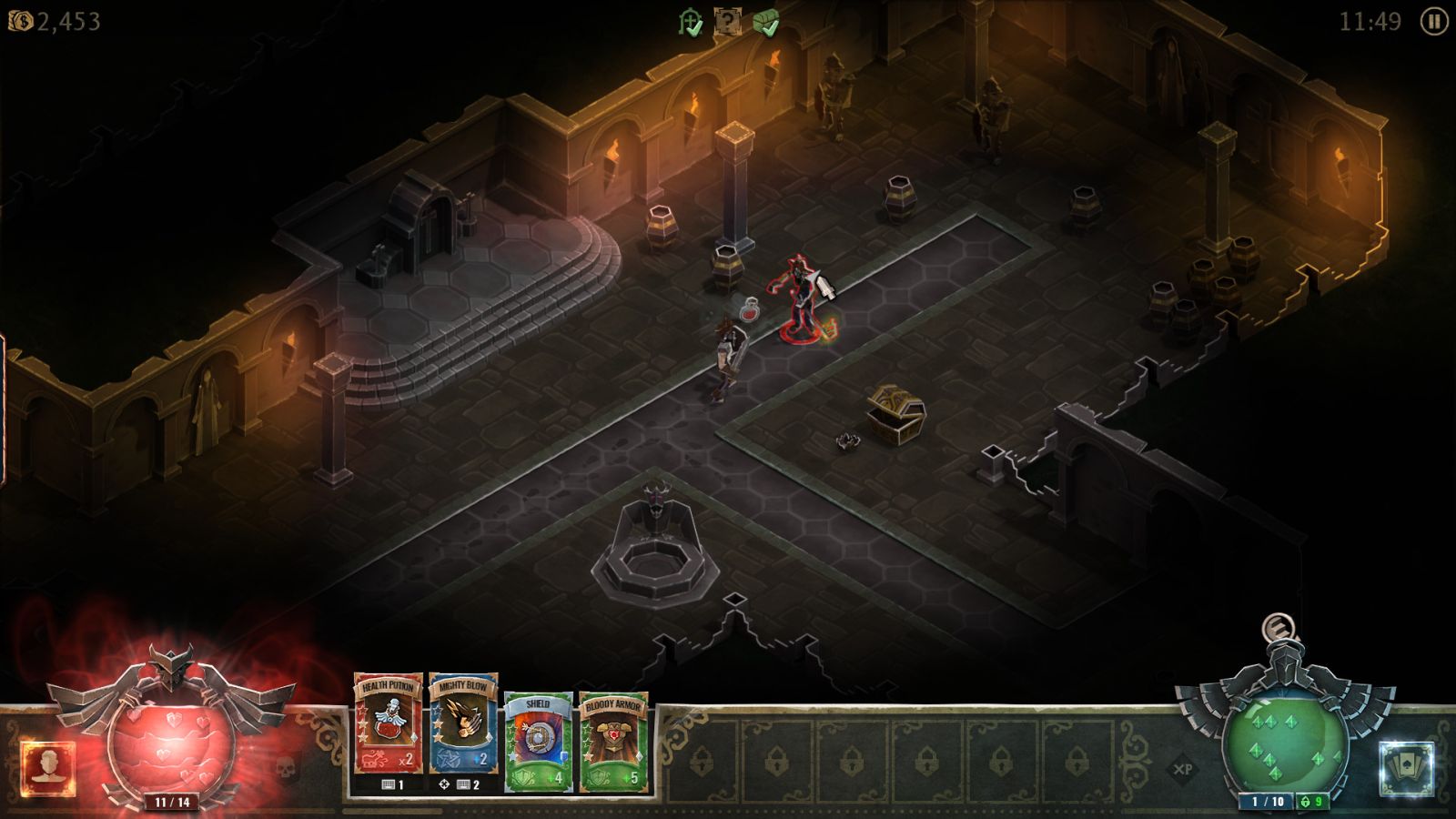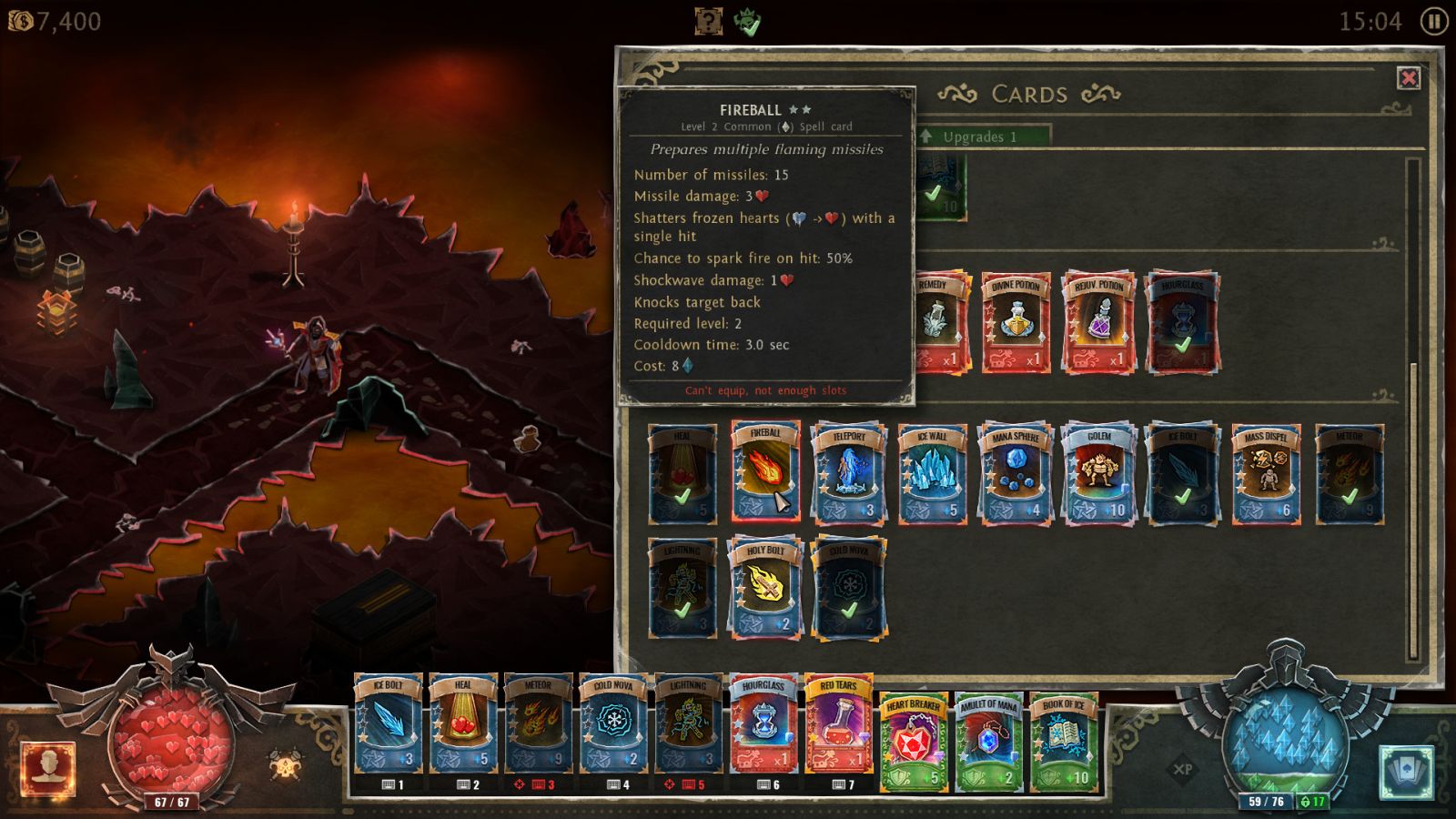
Plenty of games have either taken inspiration from Diablo or been developed as direct successors to it. Most of them try to mimic its infinitely addictive gameplay, macabre art, and pitch-black tone, but Book of Demons, a dungeon crawler that wears its debt to Diablo on both sleeves, takes a different route. Rather than mimic Diablo’s gritty art style, Book of Demons opts for a lively papercut look, and while you’ll still be facing off against hordes of demons and ghouls, that doesn’t mean you have to be deathly serious about it. Once you get into the dungeons beneath a ruined cathedral (sound familiar?), you’ll see what really makes Book of Demons different, as it trades traditional ARPG clickfest combat with a clever card-based system — there’s still a lot of clicking, though.
Book of Demons is intended as the first entry in what developer Thing Trunk is calling Return 2 Games. According to the developer, the series is meant to comprise seven games, each of which is “a tribute to a single hit game from the 90’s: a reimagining of a single universal story for a brand-new audience, using modern means and innovative gameplay mechanics.” If that’s the goal, Book of Demons is a pretty remarkable success. It’s a glowing tribute to Diablo, but it also stands on its own thanks to its unique gameplay.

You’ll spend most of your time in Book of Demons in a long dungeon that winds from the basement of a cathedral straight down to Hell (I’m guessing they got a good deal on that particular plot of land). Your ultimate goal is to defeat the Archdemon who resides in the depths, and you’ll have to fight room by room to get there. When you enter the dungeon, your character (a Warrior, Rogue, or Mage) is set on a track that leads through the dungeon. Instead of moving freely, you only issue basic commands, deciding whether to move forward or backward, and which path to take when the road forks. Similarly, basic combat is slightly automated. When an enemy enters your range, you’ll start to attack it, but painfully slowly. To speed up your attacks, you need to repeatedly click the enemy, or just hold down your mouse button. Granted, that doesn’t sound too exciting, but that’s just where things get interesting.
Instead of gaining new abilities from leveling up like in most RPGs, you’ll find new cards throughout the dungeon. These cards can represent anything from usable items and equipment to active skills and passive buffs. For instance, you might hold a potion card that you can use to regain some health (with a limited number of charges), an ability card that lets you shoot fireballs (at the cost of mana), and a passive card that lets you deflect missiles (but lowers your pool of usable mana while it’s equipped). You start out being able to hold only a few cards in your hand, but you can purchase extra slots in town. You can also upgrade cards using runes you find in the dungeon, making them more effective but also costlier to use. Building the best hand you can is key to your success in Book of Demons. It’s also a lot more flexible than most RPG skill systems. You’re free to move cards between your hand and your inventory at any time, even in the heat of battle, so you’ll never have to choose a specialization and close off other possibilities. There’s also a wide variety of cards to choose from, allowing you to add elemental effects to your attacks, teleport, stun enemies, become temporarily invincible, or just build up your defense.

While the card system is flexible in the number of different hands you can build, it is somewhat limiting in how versatile you can make a single hand. Because items, equipment, and abilities all take up card slots, loading up on one limits your access to the others. The cost of equipment also tends to be pretty high. A single good card could lock up more than half of your mana at early levels, and even late in the game, they’re an expensive investment. That means that if you want to build a very survivable character, you’ll need to spend most of your mana on defensive equipment and not have much left for spells, which could make for a dull experience. My only other gripe with the card system is that cards don’t really synergize much, like they would in a card game like Magic: The Gathering or Hearthstone. It makes sense that cards should all operate well on their own, since they’re found randomly throughout the dungeon and it keeps there from being one objectively best combination of cards, but I would have liked to be able to play cards off of each other more.
Instead of creating combos, building a good hand in Book of Demons is about switching things up to play off your enemies’ weaknesses. There’s a lot of complexity to the enemies in this game, from elemental affinities to situational invincibility. Some enemies have bonus health that’s depleted by fire or ice, while some aren’t affected by elemental damage at all. Some have shields that need to be broken, can only be damaged once every few seconds, or can’t be hurt at all until you kill the bodyguards they bring with them. Then there are mini-boss enemies with multiple phases where they launch special attacks and heal once you’ve depleted their health. The game’s three major bosses operate a lot like mini-bosses, but they also have unique mechanics and special arenas. There’s a lot to keep track of, but it’s remarkably easy to do so thanks to Book of Demons’ clever UI. Each enemy’s health is represented by a row of floating hearts above its head, which change color depending on its elemental alignment. Shields are represented by a large icon hovering over an enemy, and bodyguards are identified by a bold white line connecting them to the monster they’re guarding. You can even tell what spell an enemy is casting by an icon that appears over its head, and often cancel it if you can click the icon quickly enough. It’s extremely easy to read even in the heat of battle, even though fights can get incredibly hectic. You’ll need to swap out your cards to deal with all these factors (using the right element, equipping gear that defends against the specific threats you’re facing). Thanks to the game’s super responsive menus, and the fact that you can open your card inventory and equip a new card with just a few clicks, it’s easy to adapt even in the most dire situations.

The game’s other method of ramping up difficulty is not quite as successful. In later levels, you’ll be absolutely swarmed with enemies, many of whom spawn even more minions when they’re killed. It’s easy to get completely surrounded by spiders and go down without time to react, or walk into a room only to be instantly pelted by a dozen spears. On the other hand, when you’re facing a cluster of weak enemies that summon support, it can just become a chore to clear out rooms stacked floor to ceiling with skeletons that don’t pose any real threat. This only really started becoming an issue toward the end of the game, and even then, it didn’t sour the experience much.
As with most ARPGs, which tend to be almost compulsively playable, Book of Demons packs a ton of replay value. The game’s three classes feel quite different from each other, as their basic attacks work slightly differently and most cards are unique to one class. On top of that, the game features a perma-death mode, and once you finish the main campaign, you get access to an endless mode. If you’re a streamer, you can also play around with a couple of features recently added in the Dungeons & Streamers update, which gives viewers a variety of ways to help or hinder streamers they’re watching (but let’s be honest, they’re probably just going to screw with you).

Book of Demons is very light on story, but I really didn’t see that as a downside. Sometimes all you need is a tavern keeper telling you to go kick the devil’s ass. You do have plenty of interactions with the four townsfolk who decided they didn’t mind living next door to Hell. Each one helps you with your adventure (healing you, selling you items, upgrading or identifying your cards), and also spouts lore about the dungeon and its denizens if you care to hear it. There’s not much depth to them, but they do have loads of personality, and will even gripe about one another to you, which helps keep the tone of the game light, fitting with its papercut aesthetic.
Book of Demons
Great
Book of Demons introduces a unique card-based skill system and a sense of humor to the stuck-in-its-ways ARPG genre. It has plenty of tricks in its dungeon to keep you on your toes, but gives you ample ways to form your own strategy. With three distinct classes and an endlessly replayable quest, you can get lost in Book of Demons’ papercut dungeon for quite a while.
Pros
- Interesting card-based loot/skill system
- Plenty of variety in gameplay and equipment loadouts
- Light, funny tone and art style
Cons
- Combat encounters can feel unbalanced
- Not a lot of depth to card combinations
